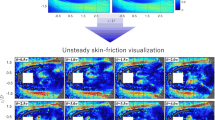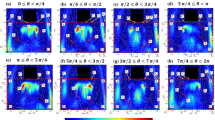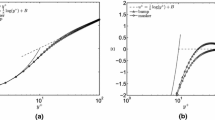Abstract
This paper presents a general method to extract a surface pressure field from a skin friction field in complex flows as an inverse problem, focusing on its application to global luminescent oil-film (GLOF) skin friction measurements. The main technical aspects of this method are described, including the basic equation relating surface pressure to skin friction, variational method, numerical algorithm, and approximate method with the constant boundary enstrophy flux (BEF). The proposed method is evaluated through simulations in the Falkner–Skan flow and the flow over a 70°-delta wing to investigate the effects of the Lagrange multiplier, downsampling rate, noise level, and the value of a constant source term in the approximate method. Further, the approximate method is applied to the skin friction fields obtained by GLOF measurements in the flow over a 65°-delta wing and the square junction flow to obtain the normalized surface pressure fields. The proposed method provides a useful tool to obtain the high-resolution fields of both surface pressure and skin friction by GLOF measurements in complex flows (particularly at low speeds).
Graphical abstract
The normalized surface pressure field extracted from the skin friction field in the square junction flow, where skin friction lines are superposed.



















Similar content being viewed by others
Abbreviations
- \(f_{\Omega }\) :
-
Boundary enstrophy flux (BEF)
- \({\varvec{K}}\) :
-
Surface curvature tensor
- \(p\) :
-
Surface pressure
- \({\varvec{n}}\) :
-
Wall-normal unit vector
- \(\hat{\varvec{n}}\) :
-
Outward-pointing normal unit vector of boundary
- \({\varvec{u}}\) :
-
Velocity
- \((x,y)\) :
-
Coordinates in a plane or an image
- \(\alpha\) :
-
Lagrange multiplier
- \(\theta\) :
-
Dilation rate, \(\theta \user2= \nabla \cdot {\varvec{u}}\)
- \(\mu\) :
-
Dynamic viscosity of fluid
- \(\nu\) :
-
Kinematic viscosity of fluid
- \(\xi\) :
-
Similarity variable
- \(\rho {\kern 1pt}\) :
-
Fluid density
- \({\varvec{\tau}}\) :
-
Skin friction
- \(\Phi\) :
-
Source term in Eq. (3), \(\Phi = \mu f_{\Omega }\)
- \({\varvec{\omega}}\) :
-
Vorticity, \({\varvec{\omega}} = \nabla \times {\varvec{u}}\)
- \(\Omega\) :
-
Enstrophy, \(\Omega = \left| {\varvec{\omega}} \right|^{2} /2\)
References
Bewley TR, Protas B (2004) Skin friction and pressure: the footprints of turbulence. Physica D 196:28–44
Buhmiler S, Rapajić S, Medić SG (2018) Finite-difference method for singular nonlinear systems. Numer Algorithms 79(1):65–86
Cai Z, Liu Y, Chen T, Liu T (2020) Variational method for determining pressure from velocity in two dimensions. Exp Fluids 61:118
Cao Y, Tamura T, Zhou D, Bao Y, Han Y (2022) Topological description of near-wall flows around a surface-mounted square cylinder at high Reynolds numbers. J Fluid Mech 933:A39
Chen T, Liu T, Wang L-P, Chen S (2019) Relations between skin friction and other surface quantities in viscous flows. Phys Fluids 31:107101
Chen T, Liu Dong ZQ, Wang LP, Chen S (2021a) Near-wall flow structures and related surface quantities in wall-bounded turbulence. Phys Fluids 33:065116.c
Chen T, Liu T, Wang L-P (2021b) Features of surface physical quantities and temporal-spatial evolution of wall-normal enstrophy flux in wall-bounded flows. Phys Fluids 33:125104
Chu J, Luckring JM (1996) Experimental surface pressure data obtained on 65o delta wing across Reynolds number and Mach number ranges.In: NASA technical memorandum 4645, NASA Langley Research Center, Hampton, Virginia 23681-0001
Husen N, Liu T, Sullivan JP (2018) The luminescent oil film flow tagging (LOFFT) skin friction meter applied to FAITH hill. AIAA J 56(10):3875–3886
Ishak A, Nazar R, Pop I (2007) Falkner–Skan equation for flow past a moving wedge with suction or injection. J Appl Math Comput 25:67–83
Kakuta T, Koyama A, Yorita D, Numata D, Nagai H, Asai K, Woodiga SA, Liu T (2010) Imaging measurement of skin friction field around bluff body using luminescent oil film technique. In: ISFV14—14th international symposium on flow visualization (Daegu, Korea, 21–24 June)
Konrath R, Klein C, Schröder A, Kompenhans J (2008) Combined application of pressure sensitive paint and particle image velocimetry to the flow above a delta wing. Exp Fluids 44:357–366
Lee T, Nonomura T, Asai T, Liu T (2018) Linear-least-squares method for global luminescent oil-film skin-friction field analysis. Rev Sci Instrum 89(6):065106
Liu T (2013) Extraction of skin-friction fields from surface flow visualizations as an inverse problem. Meas Sci Technol 24:124004
Liu T (2018) Skin-friction and surface-pressure structures in near-wall flows. AIAA J 56:3887–3896
Liu T (2019) Global skin friction measurements and interpretation. Prog Aeros Sci 111:100584
Liu T, Shen L (2008) Fluid flow and optical flow. J Fluid Mech 614:253–291
Liu T, Montefort J, Woodiga S, Merati P, Shen L (2008) Global luminescent oil film skin friction meter. AIAA J 46(2):476–485
Liu T, Misaka T, Asai K, Obayashi S, Wu J-Z (2016) Feasibility of skin friction diagnostics based on surface pressure gradient field. Meas Sci Technol 27:125304
Liu T, Sullivan JP, Asai K, Klein K, Egami M (2021a) Pressure and temperature sensitive paints, 2nd edn. Springer, Berlin
Liu T, Salazar D, Crafton J, Rogoshchenkov N, Ryan C, Woike MR, Davis DO (2021b) Skin friction structures extracted from pressure sensitive paint measurements in incident shock-wave/boundary-layer interaction. AIAA J 59(10):3910–3922
Roul P, Prasad Goura VMK, Agarwal R (2019) A compact finite difference method for a general class of nonlinear singular boundary value problems with Neumann and Robin boundary conditions. Appl Math Comput 350(6):283–304
Schlichting H (1979) Boundary-layer theory, 7th edn. McGraw-Hill, New York
Sobolev SL (1989) Partial differential equations of mathematical physics. Dover, New York
Strang G (2014) Differential equations and linear algebra. Wellesley-Cambridge Press, Wellesley
Tran TH, Amboa T, Lee T, Chen L, Nonomura T, Asai K (2018) Effect of boattail angles on the flow pattern on an axisymmetric afterbody surface at low speed. Exp Therm Fluid Sci 99:324–335
Tran TH, Ambo T, Lee T, Ozawa Y, Chen L, Nonomura T, Asai K (2019) Effect of Reynolds number on flow behavior and pressure drag of axisymmetric conical boattails at low speeds. Exp Fluids 60(3):36
Woodiga S, Liu T (2009) Skin friction fields on delta wings. Exp Fluids 47:897–911
Woodiga S, Liu T, Ramasamy RSV, Kode S (2015) Effects of pitch, yaw, and roll on delta wing skin friction topology. J Aerospace Eng 230(4):639–652
Woodiga S, Salasar DM, Wewengkang P, Montefort J, Liu T (2018) Skin-friction topology on tail plate for tractor-trailer truck drag reduction. J vis 21:1017–1029
Zhang D, Cheng L, An H, Zhao M (2017) Direct numerical simulation of flow around a surface-mounted finite square cylinder at low Reynolds numbers. Phys Fluids 29:045101
Zhong H, Woodiga S, Wang P et al (2015) Skin friction topology of wing-body junction flows. Eur J Mech B Fluids 53:55–67
Acknowledgements
Z. Cai was supported in part by the National Science Foundation of China (No. 61876104). T. Liu was supported by the John O. Hallquist Endowed Professorship and the Presidential Innovation Professorship at Western Michigan University.
Author information
Authors and Affiliations
Corresponding author
Additional information
Publisher’s Note
Springer Nature remains neutral with regard to jurisdictional claims in published maps and institutional affiliations.
Appendix: Neumann condition and Lagrange multiplier
Appendix: Neumann condition and Lagrange multiplier
The accuracy of the Neumann condition in the problem of surface pressure from skin friction is examined, and the effect of the Lagrange multiplier is discussed. As indicated in Sect. 2, the physically real surface quantities \({\varvec{\tau}}_{r}\), \(p_{r}\) , and \(\Phi_{r}\) satisfy the exact relation
where the subscript “r” denotes real quantities. In addition, from the NS equations, the pressure gradient on a surface (wall) is
where \({\varvec{\sigma}}\) is the boundary vorticity flux (BVF), \({\varvec{n}}\) is the unit normal vector of the surface, and \({\varvec{u}}_{\pi }\) is the velocity parallel to the surface. On the boundary curve (contour) \(\partial D\) on the surface, from Eq. (27), we have
where \(\hat{\user2{n}}\) is the outward-pointing unit normal vector of \(\partial D\). According to Eq. (29), the normal derivative of the physically real surface pressure at \(\partial D\) (e.g., \(\partial [p_{r} ]_{w} /\partial \hat{n}\)) is determined by the BVF \(\sigma\) or equivalently the boundary-normal diffusion of the surface-tangential velocity component \({\varvec{u}}_{\pi } \cdot \hat{\user2{n}}\).
In general, the right-hand side of Eq. (28) does not vanish automatically. Based on the fact that the BVF represents the boundary vorticity creation rate, the Neumann boundary condition \(\partial \left[ {p_{r} } \right]_{w} /\partial \hat{n} \approx 0\) holds as an effective approximation for \(\left\| {\varvec{\sigma}} \right\| \ll 1\). In other words, this approximation holds when the boundary vorticity creation rate at \(\partial D\) does not play an important role for the region concerned. This could be more reasonable when the computational domain is sufficiently large. In image processing, the computational domain is usually much larger than the region of interest, and the side effect of the Neumann condition as an approximation on the result is small.
In the variational framework, the Euler–Lagrange equation for the approximate surface pressure \(p\) is used as a model equation of Eq. (3), i.e.,
with the Neumann boundary condition \(\partial p/\partial \hat{n} = 0\) on \(\partial D\). The approximate surface pressure is expressed as \(p = p_{r} + \delta p\), where \(p_{r}\) is the physically real surface pressure (the exact solution of the NS equations) and \(\delta p\) is the error introduced by the modeling (approximation) in the variational framework. Similarly, the similar expression is \(\Phi = \Phi_{r} + \delta \,\Phi\), where \(\Phi_{r}\) and \(\delta \,\Phi\) represent the physically real source term and the corresponding error, respectively. For simplicity, it is assumed that skin friction is accurate, i.e., \({\varvec{\tau}} = {\varvec{\tau}}_{r}\). In this case, when \(\delta p \to 0\) and \(\delta \,\Phi \to 0\), the Lagrange multiplier \(\alpha\) should be sufficiently small such that the effect of the surface pressure Laplacian \({\mathbf{\nabla }}^{2} p\) can be minimized. Then, the limiting behavior of Eq. (30) is consistent with Eq. (27).
On the other hand, we consider the pressure Poisson equation
where \({\varvec{S}}\) is the strain rate tensor. Applying the pressure Poisson equation on the surface, we have
For most wall regions, the first-order wall-normal pressure derivative \(\left[ {\partial p_{r} /\partial n} \right]_{w}\) is determined by the skin friction divergence \({\mathbf{\nabla }} \cdot {\varvec{\tau}}_{r}\) that is directly related to the skin friction topology. In contrast, the effect from \(\left[ {\partial^{2} p_{r} /\partial n^{2} } \right]_{w}\) is relatively weak. For example, in unidirectional pressure-driven Poiseuille flow, this term is exactly zero. A simple analysis from Eq. (30) shows that the error \(\delta p\) in most surface regions should satisfy a Poisson equation, i.e.,
Therefore, increasing the value of \(\alpha\) tends to attenuate the source term in Eq. (33), thereby reducing the magnitude of the error \(\delta p\) and leading to a smoother surface pressure distribution. Near the separation and attachment lines dominated by the skin friction divergence \({\mathbf{\nabla }} \cdot {\varvec{\tau}}_{r}\), Eq. (33) is reduced to
For such structures, the reduction in the pressure error could be achieved by more physical modeling of the BEF and a suitable Lagrange multiplier. In summary, to meet the above requirements on the Lagrange multiplier, there is an optimal value of the Lagrange multiplier.
Rights and permissions
Springer Nature or its licensor holds exclusive rights to this article under a publishing agreement with the author(s) or other rightsholder(s); author self-archiving of the accepted manuscript version of this article is solely governed by the terms of such publishing agreement and applicable law.
About this article
Cite this article
Cai, Z., Salazar, D.M., Chen, T. et al. Determining surface pressure from skin friction. Exp Fluids 63, 152 (2022). https://doi.org/10.1007/s00348-022-03500-y
Received:
Revised:
Accepted:
Published:
DOI: https://doi.org/10.1007/s00348-022-03500-y




